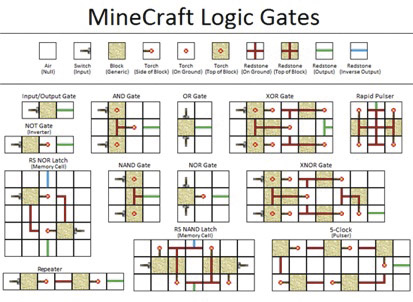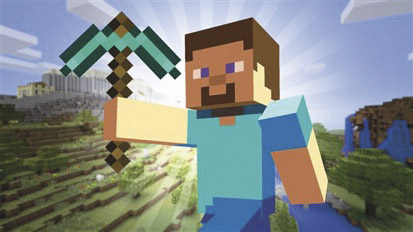By Matt Richards
The Mineclass Project is crafting new models of learning. Students and teachers from around the world are collaborating in a shared Minecraft world to explore student-directed learning communities.
If you have kids or students over the age of four, then you have most probably heard of Minecraft. It is a creative, networked computer game that has taken the world by storm. The widespread level of engagement exhibited by kids using Minecraft is unprecedented. When used for learning, Minecraft can be an amazing platform for developing 21st Century skills such as creativity, computational thinking, collaboration, and web-based project management.
I began experimenting with Minecraft as a learning platform in 2013. I used MinecraftEdu with primary students and set-up some basic projects like recreating our school in Minecraft. In 2014, I set-up an interschool Minecraft project between New South Wales and Victoria with the help of my old colleague Kieran Nolan. My students at St. Columba Anglican School Port Macquarie, and the students at Wooranna Park Primary Dandenong North, collaborate in creating their ultimate school of the future in Minecraft. This project is ongoing. Our students also participate in a live video conference every Friday to discuss the project face-to-face while collaborating ‘in-world’ in Minecraft.
In late 2014, I became a Microsoft Innovative Educator Expert. While at the induction weekend in Sydney I met some amazing educators from across Australia and New Zealand. I told them of my Minecraft project and my ideas for taking it to the global level. I wanted to develop a student-centric international learning community in Minecraft. I also wanted to make this project free. There are numerous paid Minecraft workshops, clubs, camps and books. A lot of these are excellent, but I wanted to create a free platform that any student or teacher with a desire for global games-based learning could participate in. Something I love about Minecraft is its relative affordability ($20 – $35 depending on the platform) and its open source nature. Once you pay for your initial account, you can make your own servers, skins and extras. If you have some basic java coding skills (like some of my students) you can even create your own plugins. My Microsoft peeps were super keen to collaborate and the international Mineclass Project was born.
The original team comprised five Microsoft Innovative Educator Experts from across Australia and New Zealand (Noelene Callaghan, Jodi Gordon-Moulds, Toby Trewin, Troy Smith and myself). We chose five Mineclass Jedi (secondary students well versed in Minecraft) from each of our schools. From the outset we made Mineclass a student-directed learning experience. Students create the tasks and activities (current tasks include building a working computer and calculator). Students are the server operators (OP), moderators and admins. One of my Technology (IST) students, Melissa Muney (Year 10), was already a seasoned Minecraft Administrator who ran numerous worlds and forums in her spare time. She was the first Mineclass student leader. All of our Mineclass Jedi students exhibit high level computational thinking and creativity.
One thing you learn quickly if you use Minecraft with your students is that they (probably) know more than you. They can teleport, make magic portals, create amazing structures, and basically do mind blowing stuff really quickly. I, on the other hand, dug myself into a hole on my first venture into Minecraft (to the forgiving smiles of my watching students). I asked my Minecraft savvy students to teach me. They turned out to be excellent instructors. “Being a ‘noob’ is something we all experience at first” (this is a direct quote from an in-world conversation I had recently with a Year 9 student). In Mineclass we are flipping the established top down, teacher-centric learning model that has dominated traditional education for too long. In Mineclass, students teach each other and teach the teachers.
I wrote a Mineclass blog post for Australian Teacher’s Blog that was extremely well received. Teachers from around the world started contacting me through the mineclass.org website asking if they could participate. The Mineclass project grew. At the time of writing this I am providing access to students and teachers from Thailand, America and England. I am keen to see how Mineclass evolves as a multi-lingual community. Our future plans for Mineclass are virtual excursions and student-run workshops. If you would like to join Mineclass contact me through the contact link on the mineclass.org website or tweet me @sirmattrichards. If you would like to set up your own inter-school Minecraft learning project then keep reading my (basic) instructions below.
How to set up Inter-school Minecraft Projects Objectives
Objectives include:
- Students plan, design and collaboratively create structures and functioning machines in Minecraft.
- Students learn how to communicate and collaborate effectively in web-based projects.
- Students have real global audiences for their creations.
- Students run virtual excursions for other schools in their Minecraft world creations.
Requirements
Student Minecraft accounts
It is better if the students use their own Minecraft accounts to facilitate learning anytime/anywhere. You can acquire accounts at https://minecraft.net/store/minecraft.
Server
If you have a fast internet connection (min. 50Mbps) at your school you can host the server yourself. However, minimum server requirements vary depending on the operating system your are using and the speed of your machine. For a full list of minimum requirements visit http://minecraft.gamepedia.com/Server/Requirements/Server.
If you do not have a fast connection, you can buy online Realms at minecraft.net/realms.
Devices
Minecraft works on most devices (great if you are a diverse BYOD school). Students usually prefer laptops.
System Requirements
You can catch up on the technical system requirements at https://help.mojang.com/customer/portal/articles/325948-minecraft-system-requirements
Preparation
Ensure your students all have Minecraft accounts. Initial setup is easier if you use the Minecraft Jedi in your class. Liaise with your IT Department to ensure Minecraft will be accessible on your school network. Request that they open needed ports if needed.
Ideas To Ensure Success
Set some basic rules, for example:
– students to be polite in all communications
- no griefing (griefing is a Minecraft term for being destructive or rude in-world).
Create and share with students a collaborative OneNote or Google Doc detailing the project, rules and ideas.
Students can go in-world at any time BUT there needs to be balance with time management.
Set a 30-60 minute time slot each week where students from each school meet in-world and have a live Skype/Hangout video conference at the same time so students can converse face-to-face.
Launch
Make your Mineclass project launch exciting and fun. Let your students meet in Skype/Hangout and introduce themselves face-to-face. Give them time to talk and discuss project ideas. Let them form sub-teams if required. Then let students go in-world for the first time. It is important to let them just play and muck around the first time they meet in-world. They may show off their Minecraft skills. There may be some griefing (trouble making). Use this as an opportunity to explore digital citizenship.
Project Design
The spectrum of projects in Minecraft is almost limitless. For some ideas, check out the video at http://youtu.be/RI0BN5AWOe8 . Students can create working calculators, toilets, computers, organic cells, sports stadiums with working scoreboards, etc.
Computational Thinking
Coding and computational thinking is required to create really cool working machines in Minecraft. Redstone and command block commands are the magic ingredient. Info on how to use redstone can be found at minecraft.gamepedia.com/Redstone.

Student-directed Learning
At this point in the project, most teachers begin freaking out at their lack of Minecraft skills. DO NOT PANIC! The students can teach you the basics. When the project gets to the level of sophistication where it needs special requirements from the system, you need to employ some of your students as server operators (op).
Student Admins
Ops are the admins in Minecraft. They can change variables, teleport players around, and basically be omniscient. They are a much needed resource if your project gets out of hand or students begin griefing. Choose your ops carefully. You do not want students to misuse their position of authority. This can also be a great learning experience.
Assessment
You can use Mineclass as an assessment project. Or not. If you want to link it to curriculum outcomes, use screencasts, screenshots, and conversation records as evidence.
Audience
Once your students have created their amazing structures, they can facilitate virtual excursions for students from other schools. These excursions can also be workshops where students teach other Minecraft skills.
I hope you choose to explore Minecraft as a collaborative learning platform for your students. The learning evidenced through Minecalss has been phenomenal. Have fun!

Matt Richards leads mineclass.org, the international interschool Minecraft learning project. He is a teacher and I.T. director. In 2014 He developed the first permanent K-12 Makerspace in Australian schools. In 2015, he is facilitating student experiments on the International Space Station. Matt employs emerging technologies such as the Oculus Rift and OpenROV to transform learning. Matt is a Google Certified Teacher, Google Educator Group Leader, and Microsoft Innovative Educator Expert.


Latest posts by Education Technology Solutions (see all)
- BenQ Launches First EDLA-Certified Interactive Displays for Education with Google Mobile Services (GMS) - November 17, 2023
- How AI technology is unlocking new opportunities for educators and pathways for learning - October 11, 2023
- A Strategic Implementation of Contemporary Digital Technologies - July 11, 2023
You must be logged in to post a comment.


There are no comments
Add yours